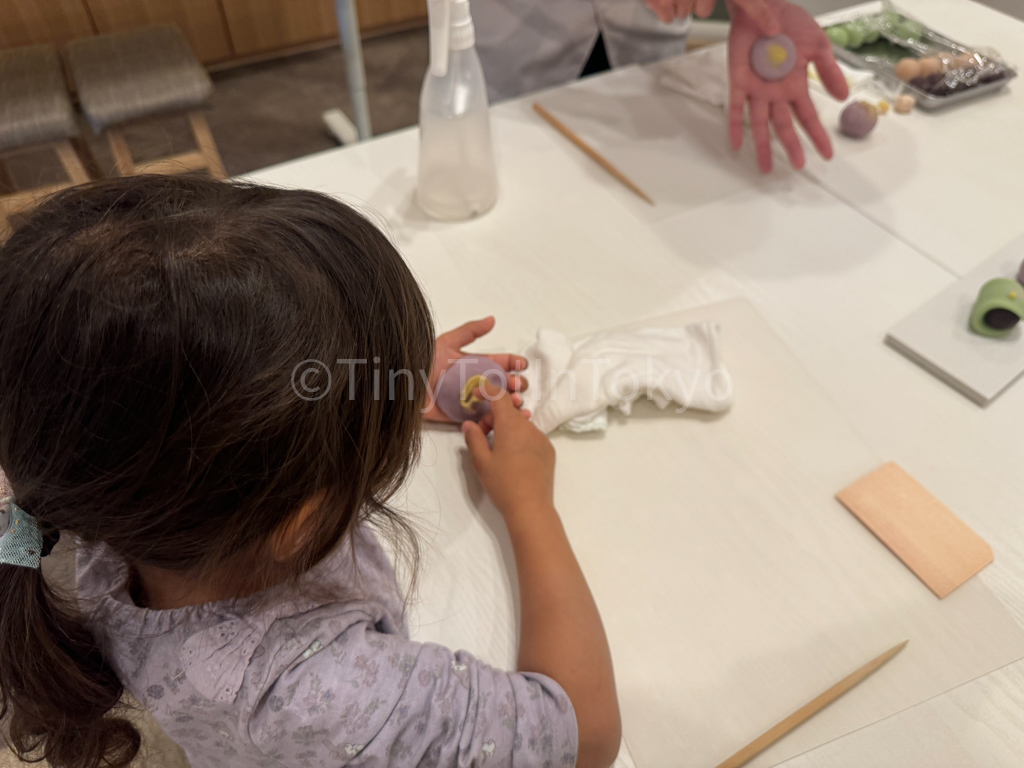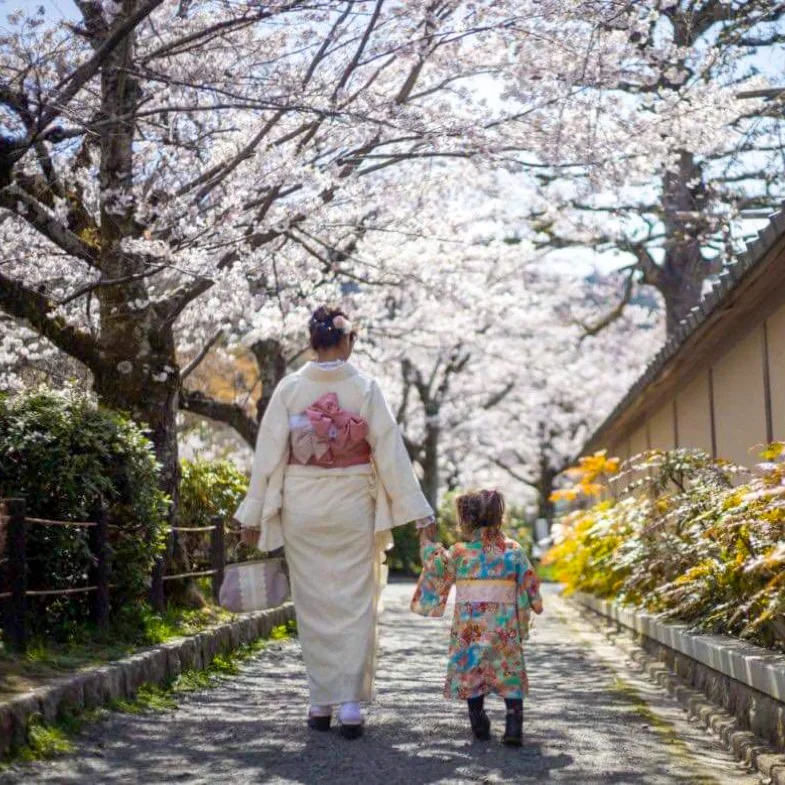Kids love hands-on, interactive activities, and perhaps more than that, they love sweets.
So what better way to introduce them to Japanese food and culture than to partake in a class where they can learn how to make wagashi?
Wagashi are traditional Japanese sweets or confectionery that primarily consist of rice flour and red or white bean paste. They also come in a variety of types such as mochi, manju, dango, and daifuku. In particular, wagashi not only taste great but also celebrate the seasons through their different colors and shapes such as cherry blossoms and leaves.
My daughter, a month away from five years old at the time of writing, loves cooking and baking (she wants to own a cake shop when she grows up) so I knew she would enjoy participating in a wagashi class where she could learn how to make Japanese sweets. Best of all, we live near Kyoto, which is one of three cities in Japan famous for traditional Japanese sweets, with the other two being Kanazawa in Ishikawa Prefecture and Matsue in Shimane Prefecture.
In fact, Kyoto has its own type of Japanese sweet known as Kyogashi, made by artisans who specialize in the craft.
In this article, I’ll share kid-friendly Japanese sweets-making experiences in Kyoto that I’ve experienced and would recommend to other parents in Japan. These classes focus on making Kyogashi, a unique experience local to Kyoto, and are taught by professional wagashi artisans.
Contents
Tokiya
Out of all the Japanese confectionary-making experiences I’ve had so far with my family, Tokiya was my absolute favorite, which is why it’s first on the list!
I’m going to be completely transparent (because having the trust of my readers is everything to me) and share that I was able to participate in this experience for free in exchange for an honest review. And I honestly feel like out of the wagashi classes I have taken so far in Kyoto, this was the best.
Tokiya is a small wagashi shop located in the heart of Kyoto near the Kyoto Imperial Palace. The store is new and beautiful, opened just last year by Nishizawa-san, who honed his Japanese confectionary skills for years at a traditional Kyoto wagashi store that has a history of over 200 years.
Since one of the most appealing points of wagashi is its beautiful appearance, it can be difficult for smaller kids to make. In fact, I went to another class (which I will mention later) that made similar wagashi but didn’t allow children under the age of five. So I was a little worried before attending the class at Tokiya and wondered if my daughter would have fun and be able to successfully make something.
Thankfully, I had absolutely nothing to worry about! Nishizawa-san was very friendly, kind, and patient with my daughter. He helped her with the more difficult parts when she couldn’t quite form the right shape or execute a step, and he knew just the right moment to step in so my daughter never felt discouraged.
In the hour-long class, we made two different types of wagashi: two kinds of namagashi, which are fresh Japanese sweets made of sweet bean paste, and a few higashi sweets, which are dried Japanese sweets.
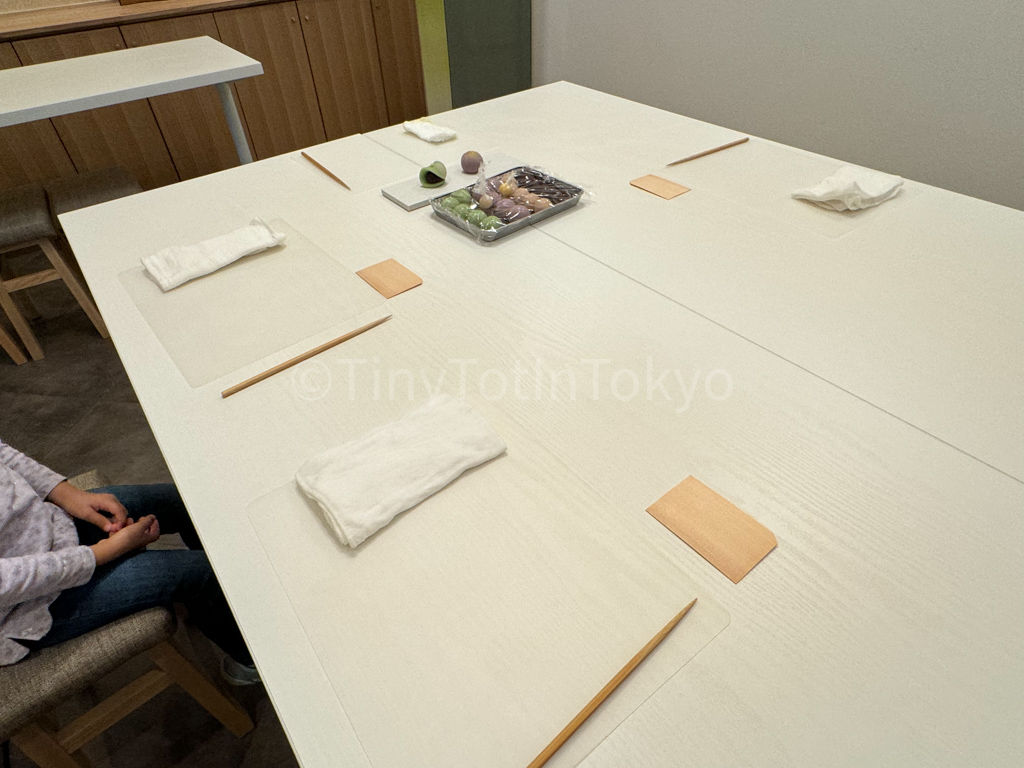
The first namagashi we made was in a round shape meant to look like an iris. This was fairly easy for my daughter to make and she said it was like rolling with Play-Doh (called nendo in Japanese), which I can see!

The second, shaped like a leaf, was a little more difficult for my daughter and even for me and my husband! But we still managed to make sweets that looked similar to Nishizawa-san’s thanks to his excellent instruction.
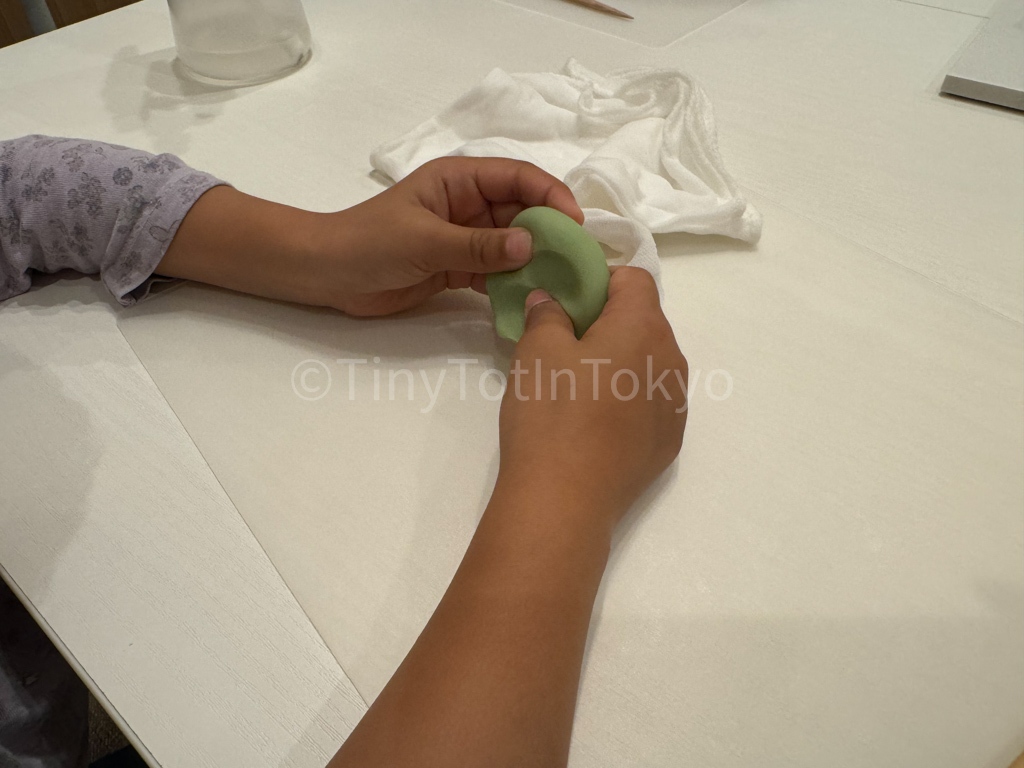
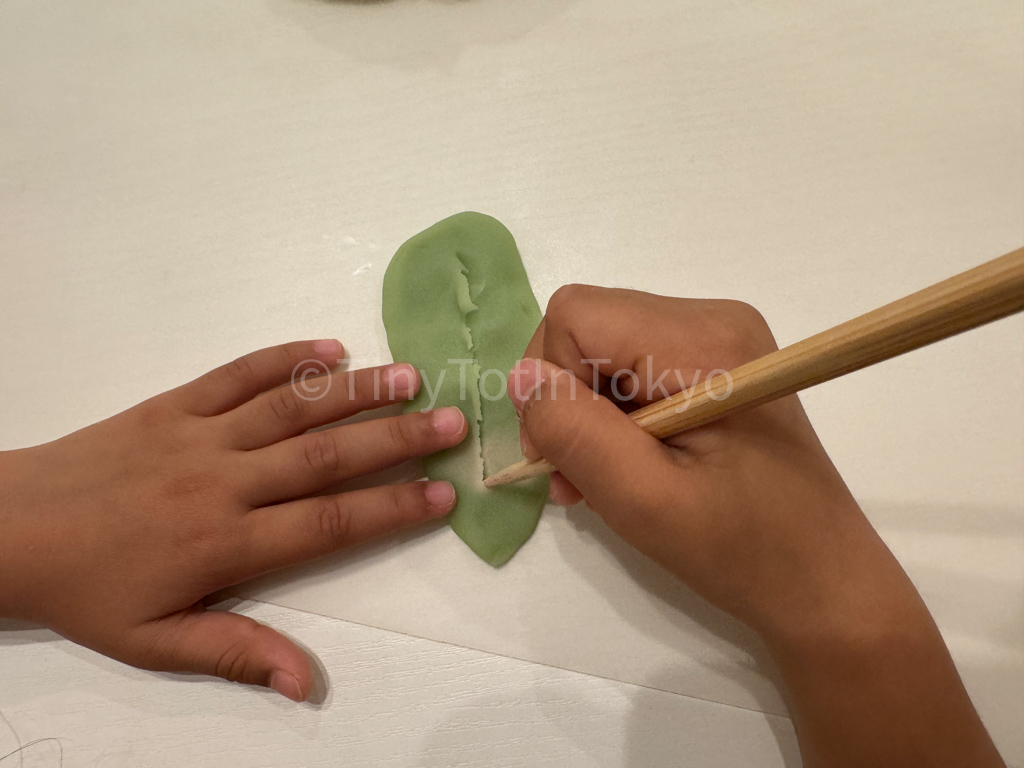
Higashi, a dried Japanese confectionary, was quite fun to make and interestingly, the molds are made by Nishizawa-san! These were made of wasabon, a premium fine-grained sugar making it the highest grade of higashi. My daughter liked putting the powdery sugar in the molds and was able to tap the higashi out of the molds with a little help.
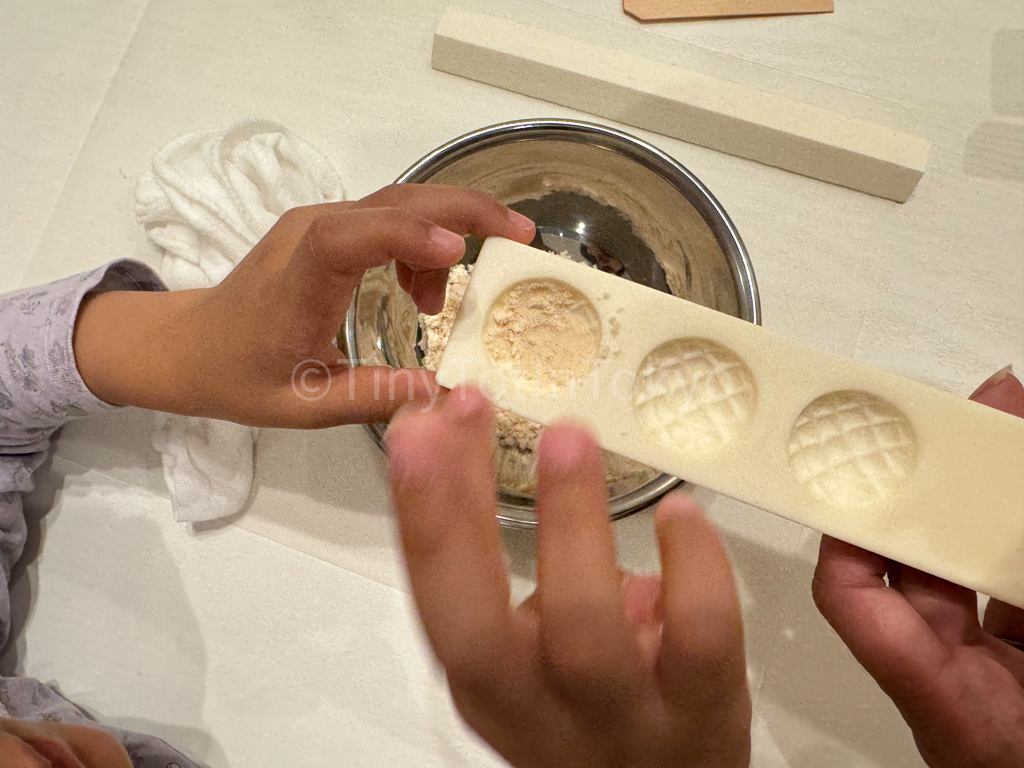

When we finished making our wagashi, we enjoyed kinton, a round, pompom-like wagashi made of white and red sweet bean paste, with a bowl of hot matcha made by Nishizawa-san.


He asked beforehand if I wanted to give matcha to my daughter but I felt the caffeine intake would be a little too much for her, so she had some genmai (brown rice) tea instead. My daughter also got a small fork to help her eat the kinton while my husband and I used a wooden stick called kuromoji.

During this time, we were able to ask Nishizawa-san questions and my husband took full advantage of this, chatting with him about how he got into the field and why he decided to open his shop. Notably, Nishizawa-san told us that he started offering these classes as a way to share the craft of making traditional Japanese sweets with people from abroad.
One important thing I want to mention is that this is the only wagashi-making experience in this article that has English interpretation included in the fee when you book through Wabunka. The other classes do not have any instruction in English. For people who don’t understand Japanese and want to learn about wagashi and Kyogashi from an artisan directly, English interpretation is essential. This is a key reason why Nishizawa-san works with Wabunka.
I also liked how it was a private lesson and we were the only participants. This was especially great when it came to my daughter because Nishizawa-san could help her directly. My daughter warmed up to him quickly thanks to this and wasn’t afraid to make a mistake, trying her best to make the sweets. At the end of the class, she said it was really fun and the smile on her face was everything. And… she might have been a little hyped up on sugar.
My husband, born and raised in Japan, also loved the experience.
At the very end, we received a nice little present to take home alongside the sweets we made — higashi shaped like a rabbit and a turtle, which comes from the name of the store in kanji, 兎亀屋, 兎 meaning rabbit and 亀 meaning turtle.

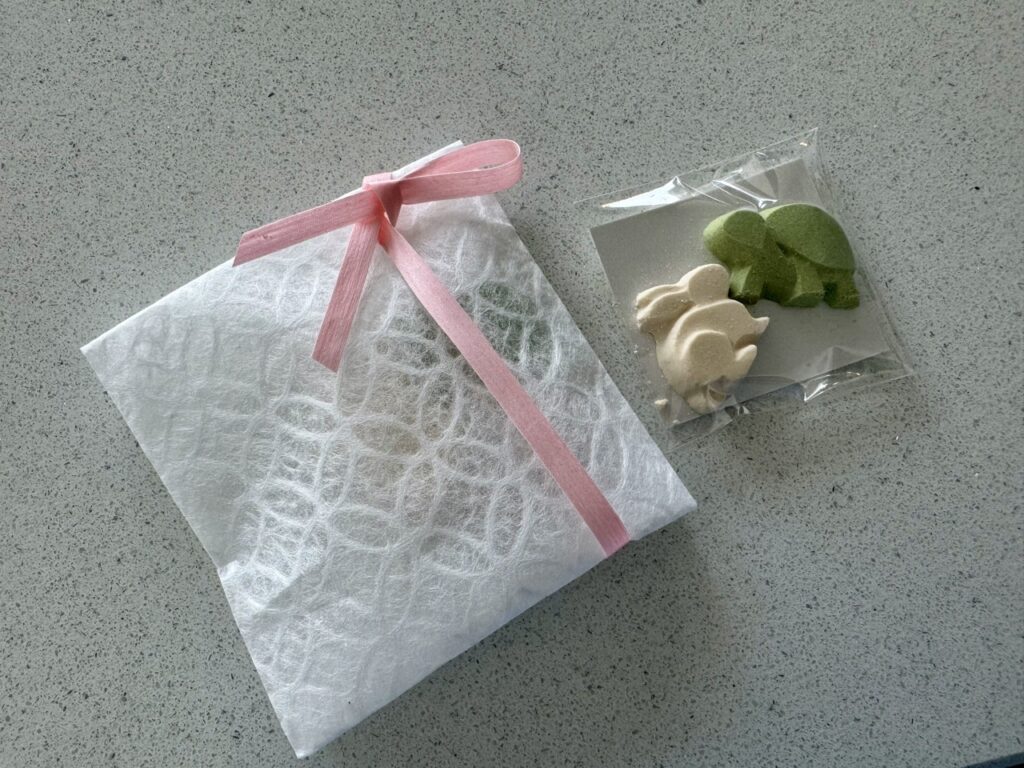
(Also, keep in mind that you’re supposed to eat the fresh wagashi that you made during the class within the day. The higashi has a later expiration date, which is on the package.)
If you’re interested, you can book a wagashi class at Tokiya through Wabunka. And if you do, make sure to ask if you can get a family photo at the end because I completely forgot!
Note that the website states that the minimum age for children is five years old. However, if your child is younger and you feel that they will be able to follow instructions (with help, of course) and be on their best behavior, then, by all means, specify this in the booking and Tokiya might make an exception as they did with my daughter.
For children six and up, you might want to consider a class at Wagashi Issho through Wabunka. It’s more affordable than Tokiya and something I really want to try but my daughter is too little at the moment. Hopefully in the future!
Kanshundo

This wagashi shop is located near Shichijo Station in Kyoto City.
I attended the class with a friend but we couldn’t bring our kids since they don’t allow children under the age of five.
This class only has instruction in Japanese, although according to their website, they have written instructions in English.
Unlike Tokiya, this class is held with other students, although we lucked out and there was no one else in our time slot.
The wagashi artisan, whose name I didn’t catch, unfortunately, instructed us on how to make the different wagashi, one dried and three fresh. These wagashi were a little more complicated to make than Tokiya’s, so I could see my daughter struggling if I were to take her and I understood why they didn’t accept younger children. But the artisan was patient with us, which I appreciated.


Similar to Tokiya, we were able to take our wagashi home in a cute takeout box and enjoyed the kinton we made with some matcha.

Although we couldn’t bring our kids, the artisan made some cute sweets for us to take home, which I appreciated. He also took a photo of me and my friend, which I completely forgot to ask Nishizawa-san at Tokiya to do! (So don’t make my mistake!)
You can book a wagashi class at Kanshundo here. (Note that this is in Japanese only.)

Otanbe
Otanbe specializes in yatsuhashi, which is a triangular sweet famous in Kyoto that’s made of mochi and sweet bean paste. There are two types of yatsuhashi experiences at Otanbe, one that involves making mochi from scratch (1 hour) and another where it’s already made and kids just put in the filling and fold it up (30 minutes).
The one-hour class is only open for kids ages 10 and up while the 30-minute class has no minimum age restriction, so kids of all ages can join.
Since my daughter was four, we did the 30-minute experience. Like at Kanshundo, this is a shared class so there was another family that joined us. The tables are separated, though.
Also similar to Kanshundo, there is no verbal instruction in English although there is a sheet in English that you can follow.
In this class, my daughter placed three different kinds of bean paste filling into mochi and then, with my husband’s help, sealed it up. It was quite easy.




We packaged up the yatsuhashi to take home to eat and also got to select three pre-made ones as well! Similar to the other wagashi classes we took, the yatsuhashi we made in the class needed to be consumed within 24 hours.

Otanbe has a stamp rally too, so kids can do that before or after the class and get a sticker.
To book a yatsuhashi class at Otanbe, visit their website here. (Note that this is in Japanese only.)
Wrap-up: Learn How to Make Wagashi in Kyoto with Kids — Family-Friendly Japanese Confectionary Classes
As you can see from the article, there are great kid-friendly options when it comes to learning how to make wagashi in Japan. Each offers a great experience for kids to learn more about the country and makes a wonderful (and delicious!) memory for the family.
Just like my other articles, I’ll make sure to update this one whenever I experience something new with my daughter.

